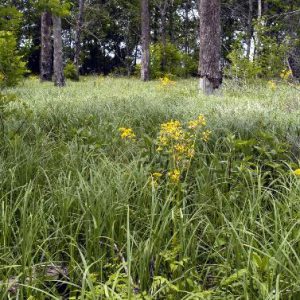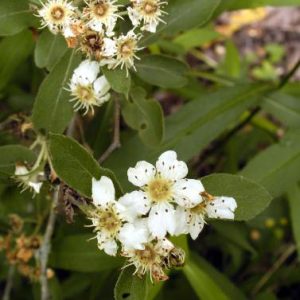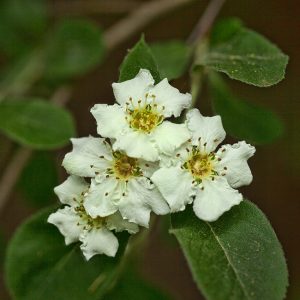calsfoundation@cals.org
Stern's Medlar
aka: Crataegus × Canescens
aka: Mespilus canescens
Stern’s medlar (Mespilus canescens or Crataegus × canescens) is a rare shrub in the rose family known in the wild from about twenty-five individual plants at a single site near Slovak (Prairie County). It was first discovered in 1969 by Jane Stern but was not named until 1990, when it was formally described (as Mespilus canescens) by Dr. James Phipps of the University of Western Ontario. Its origin, taxonomic placement, and proper scientific name are a matter of debate among botanists and represent one of the most curious and persistent mysteries in North American botany.
Stern’s medlar is a showy species with a number of desirable ornamental properties including dense groupings of quarter-sized white flowers, multiple trunks, arching branches, patchy gray and orange bark, and bright red fruit. However, it is apparently sterile, or nearly so, and all known attempts to propagate it from seed have failed. It is also difficult to propagate vegetatively, requiring either removal of rooted shoots from the base of larger plants (division) or grafting onto rootstock of certain hawthorn species. Divisions removed from several of the wild individuals are in cultivation at the Missouri Botanical Garden in St. Louis and the U.S. Department of Agriculture’s Plant Materials Center in Booneville (Logan County).
While Stern’s medlar strongly resembles a hawthorn (Crataegus), it also shares several important characteristics with the common medlar (Mespilus germanica), a hawthorn relative native to a narrow part of southeastern Europe/southwestern Asia, which has long been cultivated as a minor fruit crop and is widely naturalized in central Europe. If placed in the genus Mespilus, Stern’s medlar is the only other member of that genus and the only one native to the New World. It is endemic to Arkansas.
The extraordinary find of the Stern’s medlar promptly gave rise to the hypothesis that the plant might have originated from spontaneous hybridization between the common medlar (presumably brought to Prairie County by immigrants from Eastern Europe who settled near Slovak in the late 1800s) and wild native hawthorns (Crataegus). Support for this hypothesis was provided by Lo et al. (2007) who analyzed molecular (DNA) evidence and suggested that Stern’s medlar is indeed likely the result of a cross between the common medlar (which they considered to be better placed in the genus Crataegus, as Crataegus germanica) and one or more native hawthorns. As a result, they proposed the alternative scientific name of Crataegus × canescens for Stern’s medlar, with the “×” indicating hybrid origin.
An alternative hypothesis, also discussed by Lo et al., is that Stern’s medlar is the result of past hybridization between one or more native hawthorns and an ancient (and now apparently extinct) North American species of Mespilus. They also suggested, on the basis of DNA evidence, that the maternal parent species of Stern’s medlar was likely blueberry hawthorn (Crataegus brachyacantha) “or its ancestor.” However, as the common name of this species implies, it has blue fruit, doing little to explain the red fruit of Stern’s medlar. Lo et al. concede this point and propose that another native (red-fruited) hawthorn was also likely involved in past hybridization. It should also be noted that there are no actual records of common medlar plants in the region (either cultivated or in the wild), and the nearest known site for blueberry hawthorn is 154 kilometers to the south in western Ashley County.
The wild population of Stern’s medlar is found in a small remnant of a rare habitat known as “prairie slash” or “prairie slash woodland” in the Grand Prairie Ecoregion. These dynamic habitats occurred historically along small headwater streams at the transition zone between tallgrass prairie and wet flatwoods. In dry climatic periods, when natural landscape-scale fires were more frequent and intense, woody plants would succumb to prairies. Conversely, during wet periods, shrubs and trees would encroach into prairies, and woodlands would persist. Prairie slash was once likely widespread in the Grand Prairie Ecoregion of eastern Arkansas but has declined dramatically as prairies were plowed, the landscape was fragmented, fires were suppressed, and shrublands and woodlands grew into dense forests. In 1979, the Arkansas Natural Heritage Commission acquired a conservation easement on twenty-two acres around the wild Stern’s medlars and established Konecny Grove Natural Area.
For additional information:
Gentry, Johnnie L., George P. Johnson, Brent T. Baker, C. Theo Witsell, and Jennifer D. Ogle., eds. Atlas of the Vascular Plants of Arkansas. Fayetteville: University of Arkansas Herbarium, 2013.
Lo, Eugenia Y. Y., Saša Stefanovic, and Timothy A. Dickinson. “Molecular Reappraisal of Relationships between Crataegus and Mespilus (Rosaceae, Pyreae)—Two Genera or One?” Systematic Botany 32 (2007): 596–616.
Phipps, J. B. “Mespilus canescens, a New Rosaceous Endemic from Arkansas.” Systematic Botany 15 (1990): 26–32.
Theo Witsell
Arkansas Natural Heritage Commission
 Science and Technology
Science and Technology Konecny Grove Natural Area
Konecny Grove Natural Area  Konecny Grove Natural Area
Konecny Grove Natural Area  Stern's Medlar Flowers
Stern's Medlar Flowers 




Comments
No comments on this entry yet.